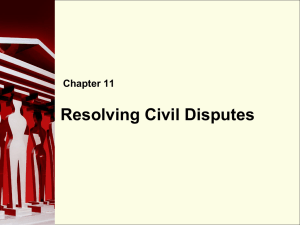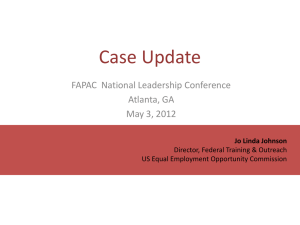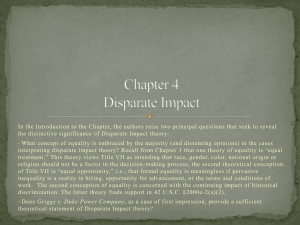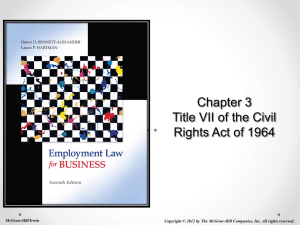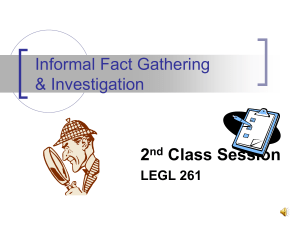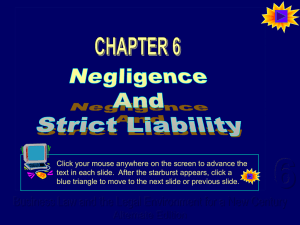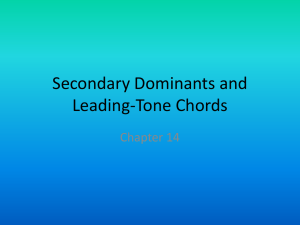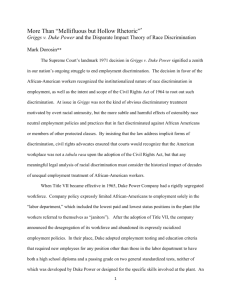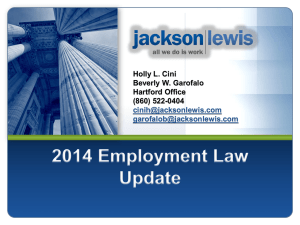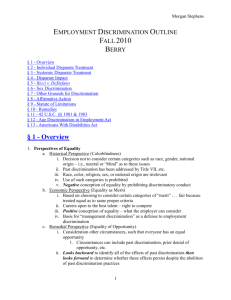Petruska v. Gannon University
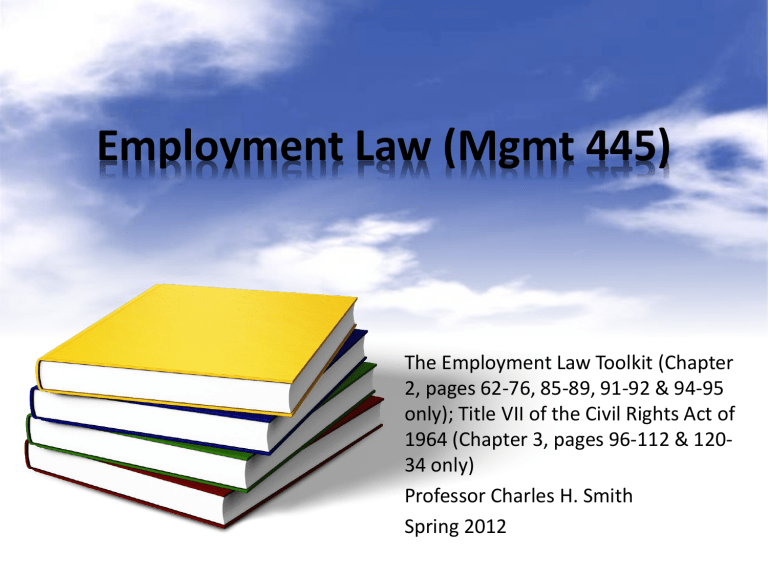
Employment Law (Mgmt 445)
The Employment Law Toolkit (Chapter
2, pages 62-76, 85-89, 91-92 & 94-95 only); Title VII of the Civil Rights Act of
1964 (Chapter 3, pages 96-112 & 120-
34 only)
Professor Charles H. Smith
Spring 2012
Introduction to Title VII
• Title VII of the Civil Rights Act of 1964 was the leading piece of legislation shaping and defining employment law rights in the U.S.
• The statute covers several types of traditional areas of discrimination but its main motivator was racial discrimination against African-
Americans – see Exhibit 3.1 on page 99.
• Before we move on, let’s review “Opening
Scenarios” on page 97.
Purpose of Title VII
• Title VII and other discrimination laws simply remove matters such as race, etc. from the employment decision-making equation.
• These laws do not provide “extra” rights or give anyone an “advantage” in the employment arena.
Coverage of Title VII
• Title VII covers discrimination based on
– Race – ethnicity, not country of origin (Chapter 6).
– Color – skin (Chapter 6).
– National origin – country of origin, not citizenship; can include
U.S.A. (Chapter 7).
– Religion – beliefs or practices (Chapter 11).
– Gender (including sexual harassment) – male, female
(Chapters 8-10).
• Note that discrimination based on matters such as age, disability and sexual orientation are not covered by Title VII though they are covered by many other federal and state statutes.
Coverage of Title VII cont.
• Who must comply?
– See Exhibit 3.8 on page 111.
• Title VII covers all levels and types of employees.
• U.S. citizens employed anywhere in the world by
American employers are protected by Title VII.
• However, non-U.S. citizens employed by
American employers are covered by Title VII only in the U.S.
Coverage of Title VII cont.
• Title VII does not govern just fundamental employment decisions such as hiring or firing; it governs many decisions about all terms and conditions of employment.
• See Exhibit 3.7 on page 110.
Coverage of Title VII cont.
• There are many exemptions in Title VII – see Exhibit 3.9 on page 112 and address the following questions and case study in small group discussions
– How can these exemptions be justified?
– Do you agree with these exemptions? Why or why not?
– Case study – Petruska v. Gannon University (pages
130-31).
Disparate Treatment
• Employee/applicant alleges that employer treats him/her differently than others similarly situated.
• Case study – McDonnell Douglas Corp. v. Green (pages 91-92) provides the three-step analysis to be followed
– Plaintiff presents his/her prima facie case.
– Defendant must show some legitimate, nondiscriminatory reason for adverse employment action (e.g., termination, not being hired) vs. plaintiff.
– Plaintiff can then prove defendant’s reason was a pretext for discrimination.
Disparate Treatment cont.
• Plaintiff must present evidence as to all elements of the prima facie case or judgment will be entered in favor of defendant
– Plaintiff belongs to protected Title VII group,
– Plaintiff applied and was qualified for the job for which defendant was seeking applications,
– Despite qualifications, plaintiff’s application was rejected, and
– After rejection, job remained open and defendant continued to seek applicants from people of plaintiff’s qualifications.
• This standard is adjusted if, e.g., termination or discipline instead of rejection; case study – Ali v. Mount Sinai Hospital on pages 133-34.
Disparate Treatment cont.
• Defendant can show that adverse employment action vs. plaintiff is based on legitimate, nondiscriminatory reason such as
– At-will employment rule – but how well would a “whim” termination play in front of a jury?
– Good cause – much stronger.
– BFOQ (aka “business necessity”) – otherwise discriminatory policy/qualification OK if legally necessary for defendant’s business; case studies – Chapter-End Question 9 (page 82) and
Wilson v. Southwest Airlines (pages 92-93); student examples.
• Plaintiff can then rebut by showing this reason is a pretext for discrimination.
Disparate Impact
• Employee/applicant alleges employer’s facially neutral policy/qualification has an adverse impact on protected
Title VII group; see if protected groups more adversely impacted than majority groups.
• Be careful to look at the real-life effect of a job qualification, company policy, etc. since no intent is needed for a disparate impact case.
• Note – “protected” group can be any group adversely impacted; e.g., men or women can be protected group in a gender discrimination case.
Disparate Impact cont.
• How to show disparate impact?
– Four-fifths rule – minority group must do at least 80% as well as majority group on job screening device or presumption of disparate impact arises; can be rebutted by defendant’s legitimate business necessity; keep in mind this is not a strict rule but only a guideline.
– Case study – Griggs v. Duke Power Co. on pages 94-95; note that Griggs was briefly overturned by U.S. Supreme Court in
1989, but then reinstated by Civil Rights Act of 1991.
– Student examples.
Reconstruction Civil Rights Laws
• The Civil Rights Act of 1964 was not the first federal civil rights statute.
• In fact, some civil rights statutes were enacted just after the Civil War, such as 42 U.S.C. § 1983 (1871) which outlaws deprivation of a person’s rights done “under color of state law” (applies to public sector employment only).
• Even though these statutes were enacted long ago, they saw little use due to conflicting state “Jim Crow” laws, custom, and acts and threats of violence.
Remedies in Employment
Discrimination Cases
• See Exhibits 2.9 and 2.10 on page 75.
• Discuss the relatively recent addition of compensatory and punitive damages in 1991
– Compensatory damages made up of what is often called general damages which are quality of life matters such as emotional distress, pain and suffering, loss of consortium, etc.
– difficult to prove with precision and can vary widely from case to case.
– Punitive damages – money awarded plaintiff to be paid by defendant as punishment; not based on general damages or special damages (e.g., lost income, medical bills).
– Query – should a person who is a victim of a Title VII violation be entitled to compensatory or punitive damages?

